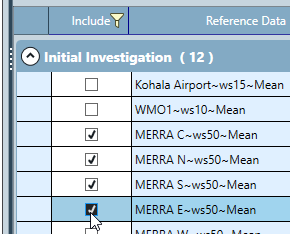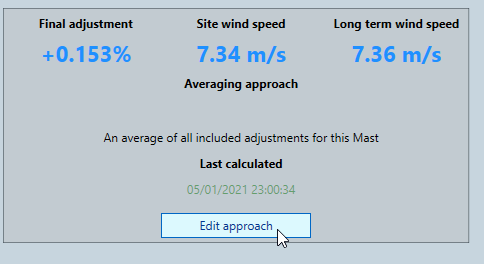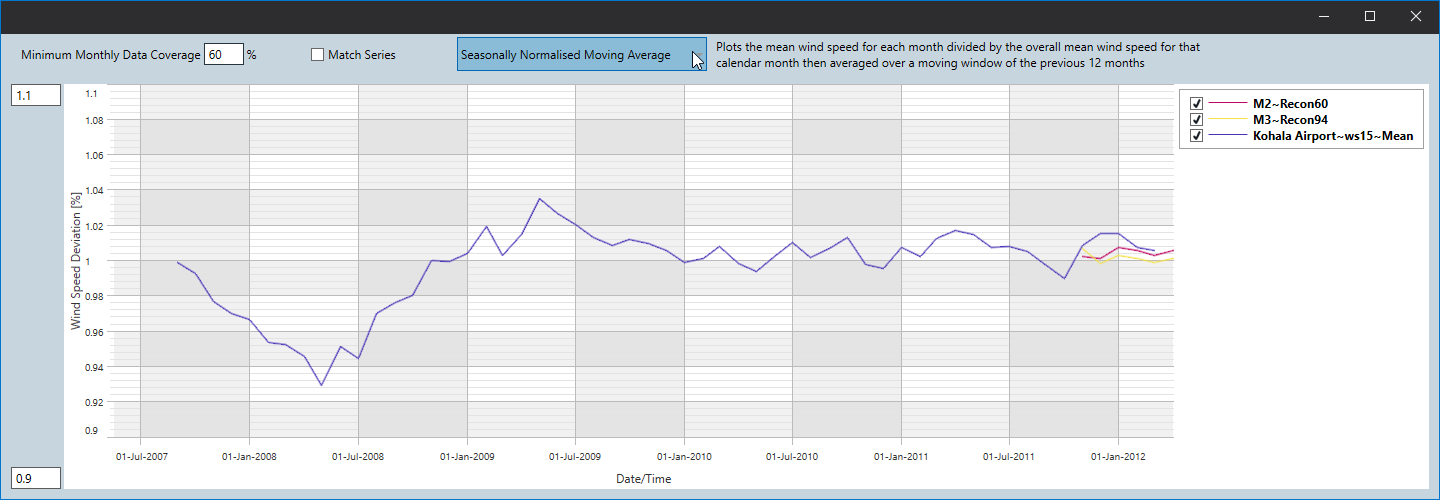Long term adjustment
Introduction
WindFarmer: Analyst includes the ability to calculate a long term adjustment and apply this to our wind climate measured on-site. We calculate a target long term wind speed at measurement height for each on-site Mast, LIDAR and SODAR using reference data. When combined with the overall shear from a shear model, this defines a long term hub-height wind speed for our calculated hub-height wind climate.
The long term wind speeds at on-site measurement sites are predicted using reference wind speed time series. The reference wind speed data can come from many sources including:
- (Free) globally available reanalysis data, MERRA 2 or ERA 5 downloaded using the Reanalysis Data task
- Measurements from an offsite nearby reference station.
- Modelled virtual time series data from a commercial provider such as DNV's VMD or Vortex Series.
Tip
Reference station data can be imported from time series text files into WindFarmer: Analyst via the Wind > Load measurement data task. For loaded data to be correctly considered as reference data the measurement site type should be set to either Reference Station or Reanalysis Node in the table in the Map > Measurement site location task.
To make a long term wind speed prediction we follow a process like that used in data reconstruction between the on-site Measurement Sites, adapted for lower resolution reference data. To derive a long term wind speed from one reference measurement site we:
- Resample the reference and site wind speed time series data to a common sampling interval (N days or months)
- Use a linear regression correlation model to derive a relationship between the (resampled) reference data and site data
- Create synthetic site data from the resampled reference data
- Splice the synthetic site data into the resampled site data
- Derive the long term wind speed from the spliced site data
For more calculation details see the calculation reference.
Long term adjustment workflow
WindFarmer: Analyst helps you investigate possible long term adjustments, then define final long term measurement height wind speeds for each measurement site. The high-level process is as follows:
- Download or load in to WindFarmer: Analyst any reference wind speed time series data you wish to consider
- Auto-setup the long term adjustment, choose appropriate settings for the investigations you wish to perform
- Review correlations between reference and site wind speed data
- Select long term predictions from reference stations you wish to include in predictions for each on-site measurement site
- Check predictions for all measurement sites in the Overview of all masts.
You should also review the consistency of the reference data you intend to use by visually inspecting the long term trends. For example, by clicking View long term consistency you may review a seasonally normalised moving average.
Auto setup for long term adjustment
Auto setup automates the process of calculating individual long term wind speed predictions for every Mast, Sodar and Lidar (site data) that could be made by considering wind speeds from each reanalysis node and reference station (reference data).
Further sets of long term predictions are generated for each selected resampling period and any selected additional investigations.
Correlation settings
| Correlation setting | Meaning |
|---|---|
| Resampling period | Time series are resampled prior to correlation. You may select both N daily and Monthly at the same time to compare. N Daily resamples the site and reference time series to a sampling interval of the specified number of days. |
| Force through origin | Determines if the line of best fit derived from a least-squares linear regression goes through the origin. If true the offset = 0 |
| Additional Investigations | You may define additional investigations to generate groups of long term adjustment options per measurement site based on different time periods. |
| Cut all reference data to the time period & Discard all reference data prior to | Can be used to check how long term wind speeds compare across long term adjustment options when the reference data sources are aligned to have the start date or same start and end dates. |
| Correlation filter: Required coverage for correlation | If a data point of the resampled time series has a lower data coverage than this, the value is excluded from the linear regression. |
| Correlation filter: Reference priority coverage ratio for splice | The long term wind speed is derived by splicing synthetic site wind speeds generated from the reference data in to gaps in the site data. If Sitecov / Refcov is less than this value for a record, then we use the synthetic reference data in preference to the site data. |
| Uncertainty settings: Wind speed Inter-annual variability | How much the wind speed can vary on a year-on-year basis. Default value of 6% |
Site data
| Setting | Notes and defaults |
|---|---|
| Correlation | The wind speed time series to be used in the correlation with each set of reference data. The default is the primary height Parallel Measurement Combined (PMC), or measured wind speed time series, not the Reconstructed (Recon) time series. This avoids compound errors that could be introduced in some cases if we were to correlate the Reconstructed time series. |
| Long Term Wind Speed | The synthetic site wind speed time series will be spliced into this site wind speed time series and the spliced result will define the long term wind speed. The default selection is the primary height Reconstructed (Recon), Parallel Measurement Combined (PMC), or measured wind speed time series |
| Start time period, End time period | Together these settings define the period of site measurements to be used. The default is to use the entire period of measurements, but it is also possible to cut the start and end times of each individual time series. |
Reference data
| Setting | Notes and defaults |
|---|---|
| Start time period, End time period | The default is to use the entire period of measurements, but it is also possible to cut the start and end times of each individual reference data time series to account for specific consistency issues you may know of. These cuts are applied before any others defined within the Additional investigations. |
| Reference consistency uncertainty | The consistency uncertainty of a reference data source. Fixed value of 2%. |
Combine predictions from multiple sources
To derive an average long term measurement-height wind speed when considering multiple sources of reference data, we have the option average the predicted wind speeds by checking include for multiple long term adjustment options.

After selecting options to include you can review the predicted long term wind speed and adjustment relative to the site wind speed. You can further edit the approach to use average adjustment predictions at each mast across selected site masts that you believe should have the same long term adjustment, or enter your own manual adjustments.

Review long term wind speed predictions for all measurement sites
Once you have calculated long term wind speeds for each measurement you can see the overview of all masts to compare the long term wind speeds, adjustments and included data side by side for each measurement site to check your approach.
Long term consistency
You can launch the long-term consistency view from the long term adjustment task. Within this view you can see long term data trends in the data and overlay several time series to help you visually identify possible consistency issues in long term reference datasets.

A consistency issue is typically an apparent change in the underlying annual wind speed distribution over the long-term period. This might be the result of something like a change in instrumentation or, for modelled data such as reanalysis, a change in the model code or the model inputs (e.g. the introduction of satellite data).
A variety of averaging methods are provided that try to aggregate and plot the long-term datasets in a way that will reveal a change to the distribution (mean or standard deviation or both). You should look for any significant change points in your reference data which could indicate a bias in long term adjustments and, potentially, discard reference data prior to change points from the long-term adjustment calculation.
